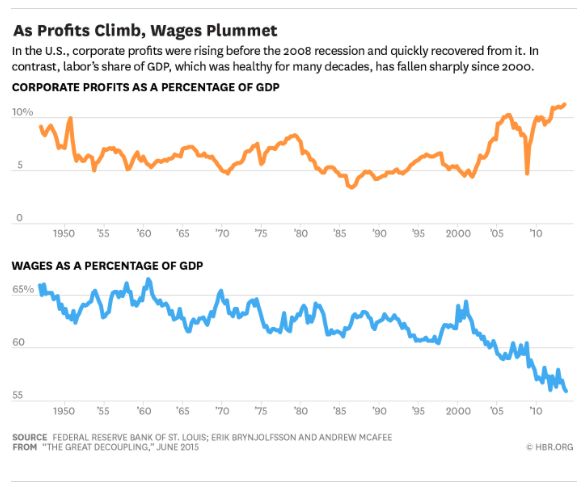 Expressions often have a deeper meaning than the words that form them. This is typically the case with those depicting the new conditions of work, turned upside down by the rise of networks and technology. The first expression was “Enterprise 2.0”, pointing to the most representative form of human production activity, the company. Then came “social business”, in which the organization was replaced by the activity. Today, “digital transformation” is trending, that completely ignores the subject of this transformation, allowing to refer to changing conditions without grounding them in their context. Pure coincidence? It is indeed much easier to deal with change without tackling much more uneasy questions regarding the nature and purpose of our organizations. Everything happens as if we were so deeply immersed and conditioned by our Judeo-Christian roots than the unescapable necessity of work as a foundational burden was taken for granted. Yet, the necessity to understand at a deeper level the nature and purpose of businesses has become critical in order to build the future.
Expressions often have a deeper meaning than the words that form them. This is typically the case with those depicting the new conditions of work, turned upside down by the rise of networks and technology. The first expression was “Enterprise 2.0”, pointing to the most representative form of human production activity, the company. Then came “social business”, in which the organization was replaced by the activity. Today, “digital transformation” is trending, that completely ignores the subject of this transformation, allowing to refer to changing conditions without grounding them in their context. Pure coincidence? It is indeed much easier to deal with change without tackling much more uneasy questions regarding the nature and purpose of our organizations. Everything happens as if we were so deeply immersed and conditioned by our Judeo-Christian roots than the unescapable necessity of work as a foundational burden was taken for granted. Yet, the necessity to understand at a deeper level the nature and purpose of businesses has become critical in order to build the future.
The next logical step
The change from industrial structures toward platforms that we are witnessing has deep implications, way beyond requesting the evolution of managerial practices. To understand them, it is useful to get some background from the theory of organizations. From an economic point of view, one of our main understandings of the nature of commercial organizations is derived from a short essay written in 1937 by Ronald Coase and entitled The Nature of the Firm.
For Coase, entrepreneurs gathered individual workers under the aegis of large entities to minimize the costs associated with transactions. Firms, and their internal mechanisms, would then be much more cost-efficient than the supply and demand effects involved in free markets. Yet, as I have already written, this efficiency alone has vanished, as the pressure of technology now allows almost everyone to produce goods and services at almost no cost. Thus, the transition to companies as platforms, harnessing the capabilities of networked individuals to provide or even produce on-demand goods and services, giving birth to what we call the sharing economy, is the next logical step. But should we call it a step forward?
The revenge of the markets
Commoditized consumption and the raw effects of markets’ mechanisms have lowered the price of most of the goods and services we use in our day-to-day life. But what is true for individuals is not necessary the case for companies. An organization, for instance, would pay at least ten times more than I do the same internet fiber access I am enjoying. Booking a flight within the context of a corporate contract usually costs much more, rear setback set apart, than the ones I can find on my own. In these cases, the transaction costs associated with the exchange are much higher for a company than for an individual, because of the many added layers they include: taxes and costs required to maintain a bureaucratic structure, of course, but also, and more importantly, costs necessary to ensure the liability and the repeatability of the transaction.
For a buyer, most of the transactions involved in dealing with platforms do not take these costs into account, but rather provide minimal liability support over free markets. Would they want to ensure better repeatability, they would have to rely on heavier bureaucracy and enforce stricter procedures. From a purely transactional point of view, platforms only represent an artificial advantage over industrial firms, advantage that may disappear once stabilization and efficiency of the newly created markets take place.
Technology versus work
There is another way to look at the economic nature of organizations. The resource-based – or capability-based – view, instead of considering a general mechanism under which companies settle and grow, focuses on the way they organize themselves and operate in order to succeed over markets and over their competitors.
Building from it to better explain how firms evolve and respond to rapidly-changing environments, the knowledge-based theory consider knowledge as the most important capability of a company. For a platform company relying on a network of workers, relying on collective intelligence looks like a fabulous premise. But fact is that most of its actionable knowledge comes from ever more sophisticated algorithms, not from human wisdom. Amazon’s Mechanical Turk gets its power from cleverly computerized division of labor, the strength of BlaBlaCar comes more from the precision with which it links short rides from car sharers into long distance journeys. The list could go on forever. From a knowledge-based point of view, platforms companies represent a bright future for technology, not for workers.
Disposable business models
The theory of dynamic capabilities, exposed and developed by David Teece in the beginning of the nineties, proposes a larger view upon capabilities. In The Dynamic Capabilities of Firms: an Introduction, cowritten with Gary Pisano, he set the basis of his theory, writing that :
“We posit that the competitive advantage of firms stems from dynamic capabilities rooted in high performance routines operating inside the firm, embedded in the firm’s processes, and conditioned by its history. Because of imperfect factor markets, or more precisely the non-tradability of ‘soft’ assets like values, culture, and organizational experience, these capabilities generally cannot be bought; they must be built.”
For Teece, the reorganization of available resources, through reconfiguration of its assets, through learning and building high performance routines, are the core elements that characterize a company.
In the case of a platform company, most of the resources are externalized. Work is outsourced, and with it most of the capabilities allowing them to evolve. Without a supportive organizational framework, routines building and learning is left over to individuals, and cannot be capitalized at global level, unless people working from them form true, tightly coupled networks. Innovation thus can only occur at the core level, further limiting the ability of platforms to adapt to a new environment. Fact is that most of these companies build a competitive advantage from a very limited set of ideas and processes, within a fixed business model. Once this one is challenged and the company is unable to sustain it, it usually move on to another project. The whole “real economy” (the production of goods and services, without financial-only wealth accumulation), is becoming the playground for a startup mindset. Pivoting has replaced evolving, whatever the consequences for workers might be.
An history of exhaustion
The maybe only path on which the platform company can be seen as a step forward is in fact a negative one. The history of the firm with regards to its relationships with technology, which can be traced back to the invention of the flying shuttle by John Kay in 1733, follows its own radical logic: the exhaustion of resources. The race toward greater productivity, typical of the Industrial Revolution, has pushed companies to overexploitation of natural resources and fossil energy. The next step has been -and still is for many companies- about efficiency and cost cuttings, leading to exhaustion of internal resources and to the programmed agony of salaried status. The following figure shows pretty well the growing decorrelation between profits and the gross share of salaries.

By encouraging the commodification of services otherwise freely exchanged in a social context, aren’t platform companies taking exhaustion one step further, eroding the tissue of our society itself?
A contractual node
Do not let us fool ourselves by the fact that the platform company use networks as their primary resources. Organizational theory seems to tell us that they represent a dead end, a local maximum, in the evolution of work, and are, under many aspects, a regression from the company of the Industrial Age. To try envisioning a brighter future, we definitely need to look for more sustainable structures. Here too, theory can provide some clues.
For this, let us get back at Coase, or rather at Oliver Williamson, who, building on Coase’s ground, developed the transaction costs view of the firm. For Williamson, the more specific knowledge transactions require, and the more uncertainty exists in their outcome, the more likely they are to take place inside organizations to minimize the costs involved. Central to his conception is that this optimisation is linked to two different layers of relationships between the actors involved. First, a lattice of contractual bonds, internally as well as externally between the buyer and the supplier. Then, as these contracts are considered as incomplete – they cannot cover any possible situation -, a layer of governance based on authority, allowing its beholder to make decisions in all cases not covered by the contracts.
In its will to control, the industrial firm has evolved toward bureaucratic behaviors, tightening hierarchies as structure of authority, and contributing in tailoring the law of contracts to their own interest, from expressions of the principle of good faith to formal straightjackets, as Grant Gilmore exposed in his classical The Death of the Contract. Platform companies follow a different path, dismissing the governance layer to rely on the markets to resolve what is left over by contracts.
Diving into the unknown
Is resorting to markets clearly a sustainable solution? I really don’t think so. The purpose, as well as the mechanics, of human transactions do not reduce themselves to market dynamics. The need for people to gather to reduce the costs involved with these exchanges is a constant, not only from an economic only point of view. Our challenge is, to be able to guide organizations of today, we have first to understand the shape of things to come, which includes organizational structures as well as the contractual framework that will glue these structures internally. As our personal and professional life melt into each other, and as the workplace more and more expands into the space of the city, we have also to understand who the actors of these new dynamics are, and what their responsibility toward each other is.
Sure, there is a deep digital transformation at work. and we need new organizational principles and frameworks to guide us through. And let us humbly recognize that we are diving into the unknown.
Image: Howard Pyle illustration of pirate walking the plank, from Howard Pyle’s Book of Pirates. -public domain-





